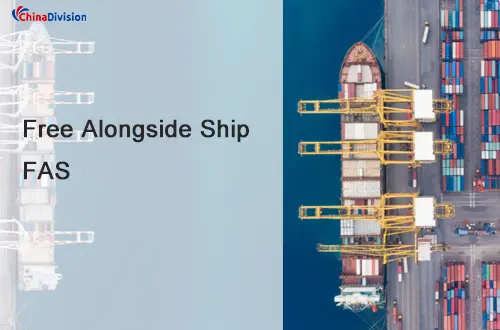Differentiation Comparison Between FAS and FOB/CIF/FCA
In the wave of global trade, how to accurately select trade terms has become the key for B2B companies and e-commerce sellers to improve supply chain efficiency. Chinadivision found that many companies still have a superficial understanding of the term "Free Alongside Ship (FAS)", which leads to cost overruns and risk allocation disputes in actual operations. This article will answer in detail the common doubts of B2B companies and e-commerce sellers about FAS, and provide professional solutions to help you better understand and apply this term.
Table of Contents
What is Free Alongside Ship (FAS)?
FAS (Free Alongside Ship), namely "delivery alongside the ship (named port of shipment)", is a special term for sea/inland waterway transportation specified in the "International Commercial Terms". The core is:
Division of responsibilities
The seller needs to deliver the goods to the shipside of the designated port of shipment (such as the dock or barge) and complete the export customs clearance procedures, that is, complete the delivery obligation, and the buyer bears all costs and risks from this point, including loading, shipping, insurance and destination port fees.

Applicable scenarios
Applicable to scenarios where the goods need to be transferred by barge, port facilities are limited or the buyer wants to directly control the transportation link. FAS terms are applicable to sea or inland waterway transportation.
Advantages and highlights of FAS
- Clear division of responsibilities
FAS clarifies the responsibilities and obligations of buyers and sellers during the transportation of goods, reducing disputes caused by unclear responsibilities.
- Reduce transportation risks
After the seller delivers the goods at the shipside, the risk is transferred to the buyer, reducing the seller's risks during transportation.
- High flexibility
FAS is applicable to a variety of transportation methods, including sea and inland waterway transportation, providing high flexibility.
- Cost controllability
The seller does not need to bear the cost of loading and shipping, which is suitable for small and medium-sized enterprises with limited budgets.
- Convenient customs clearance
The seller is responsible for export customs clearance to avoid cross-border compliance risks.
- Suitable for bulk cargo transportation
FAS is often used for commodities that need to be transported in bulk, such as agricultural products, minerals, and industrial raw materials, and is particularly suitable for trade scenarios that require sea transportation.
Comparison of differences between FAS and FOB/CIF/FCA
1. FAS vs FOB (Free On Board)
Differences in delivery points
The seller only needs to deliver the goods to the shipside, and the risk is transferred to the buyer at the shipside. FOB delivers the goods on board, and the seller is responsible for loading the goods on board, and the risk is transferred to the buyer when the goods pass the ship's side. If the buyer's designated ship cannot dock, the seller must bear the barge fee (according to the FAS terms, this fee is borne by the buyer).
Risk transfer node
FAS is bounded by the shipside, and FOB is bounded by the goods crossing the ship's side.
Application scenarios
FOB is more suitable for situations where the seller is able to arrange shipment, while FAS is more suitable for situations where the seller cannot arrange shipment.
2. FAS vs CIF (Cost, Insurance and Freight)
Cost structure
The seller is responsible for paying the transportation costs and insurance premiums of the goods and transporting the goods to the destination port. FAS only covers the cost to the ship's side, and the subsequent transportation and insurance costs are borne by the buyer.
Risk Coverage
The CIF seller needs to insure the goods, while the FAS buyer arranges the insurance by himself. If the goods are damaged during transportation, the CIF seller may get into a dispute due to the insurance clause dispute.
Application Scenarios
CIF is more suitable for situations where the seller is willing to bear more transportation responsibilities, while FAS is more suitable for situations where the buyer is willing to bear more transportation responsibilities.
3. FAS vs FCA (Free Carrier)
Transportation Mode Restrictions
FAS is only applicable to sea/inland waterway transportation. The seller delivers the goods at the ship's side and the risk is transferred to the buyer at the ship's side. FCA can cover multimodal transportation. The seller delivers the goods to the carrier at the designated location, and the risk is transferred to the buyer.
Scope of Liability
The FCA seller needs to bear the risk of delivering the goods to the carrier, while the FAS is limited to the ship's side. If the goods are delayed due to port congestion before loading, the FCA seller may be liable for breach of contract.
Application Scenarios
FCA is applicable to multiple modes of transportation, while FAS is mainly applicable to sea and inland waterway transportation.
When to choose FAS? ——Chinadivision's practical advice
Buyer-led transportation
FAS can give buyers greater flexibility when they want to directly control the transportation route, carrier selection or insurance arrangements.
Seller unable to arrange loading
The seller may not be able or willing to arrange the loading of the goods, and FAS is a suitable choice at this time.
Port facility restrictions
If the loading port lacks loading and unloading equipment or the ship cannot dock, the FAS clause can clarify the sharing of barge costs to avoid disputes.
Cost optimization needs
For exporters in landlocked countries, giving the buyer the right to negotiate freight through the FAS clause can reduce logistics costs.
Sea or inland waterway transportation
FAS is mainly applicable to sea and inland waterway transportation, not to other modes of transportation.
Common pain points and solutions for Free Alongside Ship
Is FAS suitable for container transportation?
Not applicable. FAS is not suitable for containerized cargo because containers are usually delivered to dedicated terminals rather than directly beside the ship. For container transportation, FCA (Free Carrier) or FOB (Free on Board) is more appropriate.
How to manage the risks of FAS?
The seller should ensure that the goods are in good condition when delivered at the ship's side, and the buyer should choose reliable transportation and insurance services to manage the risks during transportation.
Who is responsible if the goods are damaged at the ship's side at the port of shipment?
If the damage occurs after the seller delivers the goods to the ship's side, the responsibility shall be borne by the buyer. It is recommended that the buyer purchase "warehouse to warehouse" insurance to cover the risks from the port of shipment to the destination.
How to ensure that the documents are adequately prepared when using FAS?
The seller needs to provide packing list, invoice and certificate of origin, and ensure that the transportation documents match the goods information. ChinaDivision can assist customers in preparing and checking documents to avoid affecting logistics efficiency due to false information.
Is FAS suitable for small and medium-sized cross-border e-commerce sellers?
FAS is more suitable for bulk goods trade, but small and medium-sized sellers can consider choosing FCA or FOB.
How to ensure that the goods are transported smoothly to the port of shipment?
Choose a reliable logistics partner to ensure safe and timely transportation. ChinaDivision provides one-stop logistics services, worry-free from transportation to loading.
How does Chinadivision safeguard FAS transactions?
1. Full-process control at the port of shipment
Visual tracking of cargo collection, terminal stacking, and loading and unloading; coordination of port resources, priority arrangement of loading and unloading, and avoidance of demurrage.
2. Customized risk plan
Design "shipping delay insurance" and "cargo damage emergency treatment" plans for buyers; provide "export document compliance review" for sellers to avoid customs clearance risks.
3. Cost optimization combination
Integrate FAS goods from multiple suppliers, ship in LCL, and reduce unit logistics costs; provide flexible solutions for FAS to FOB/CIF to meet different order requirements.
For B2B companies and e-commerce sellers who transport bulk or non-containerized goods by sea, Free Alongside Ship (FAS) is an important international trade term. It provides sellers with clear division of responsibilities and cost control, while allowing buyers to control the transportation and import processes. However, FAS requires buyers to manage loading, freight, insurance, and import customs clearance by themselves, which can be complicated.
Understanding FAS and applying it correctly can help cross-border e-commerce sellers and B2B companies optimize logistics costs and risk control. ChinaDivision is committed to providing customers with professional support and solutions, allowing you to easily cope with international logistics challenges. Contact ChinaDivision now to learn more about FAS and other trade terms logistics solutions! Make international trade more efficient and more secure!





